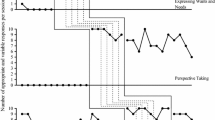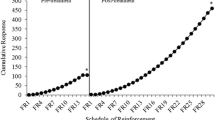Abstract
Lag reinforcement schedules have been shown in previous research to be an effective intervention for teaching verbal and nonverbal response variability to individuals with developmental disabilities. In more recent research, variability itself has been considered a reinforceable behavior in its own right (Susa & Schlinger, The Analysis of Verbal Behavior, 18, 125–130, 2012). Lag x schedules of reinforcement can be used to teach variability by using contingencies that require responses to differ from previous responses. The present study extended Susa and Schlinger’s, The Analysis of Verbal Behavior, 18, 125–130, (2012) research by using 3 social questions instead of 1 in a random rotation and included probes to test for generality. A changing-criterion design was used to evaluate the results with one 11-year-old female participant diagnosed with autism. During baseline, the participant provided little variability, with rote responses. During the Lag 1 and Lag 2 phases, appropriate variable verbal responding increased with the use of echoic prompts, visual aids, and an error correction procedure. Further, the results also showed that the participant learned to vary her responses by demonstrating the ability to emit 11 novel prompted responses and 13 spontaneous responses.
In addition, the participant was able to retain the skills learned in a maintenance probe conducted 4 weeks postintervention.

Similar content being viewed by others
References
American Psychiatric Association. (2013). Diagnostic and statistical manual of mental disorders (5th ed.). Arlington, VA: American Psychiatric Publishing. https://doi.org/10.1176/appi.books.9780890425596
Baruni, R. R., Rapp, J. T., Lipe, S. L., & Novotny, M. A. (2014). Using lag schedules to increase toy play variability for children with intellectual disabilities. Behavior Interventions, 29, 21–35. https://doi.org/10.1002/bin.1377
Cammilleri, A. P., & Hanley, G. P. (2005). Use of a lag differential reinforcement contingency to increase varied selections of classroom activities. Journal of Applied Behavior Analysis, 38, 111–115. https://doi.org/10.1901/jaba.2005.34-04
Ciccone, F. J., Graff, R. B., & Ahearn, W. H. (2006). Stimulus preference assessments and the utility of a moderate category. Behavioral Interventions, 21, 59–63. https://doi.org/10.1002/bin.207
Cooper, J. O., Heron, T. E., & Heward, W. L. (2007). Applied behavior analysis. Upper Saddle River, NJ: Prentice Hall.
Heldt, J., & Schlinger, H. D. (2012). Increased variability in tacting under a lag 3 schedule of reinforcement. The Analysis of Verbal Behavior, 28, 131–136. https://doi.org/10.1007/bf03393114
Jones, R. S. (1990). The social effects of stereotyped behavior. Journal of Mental Deficiency Research, 34, 261–268.
Lee, R., & Sturmey, P. (2014). The effects of script-fading and a lag-1 schedule on varied social responding in children with autism. Research in Autism Spectrum Disorders, 8, 440–448. https://doi.org/10.1016/j.rasd.2014.01.003
Lee, R., McComas, J. R., & Jawor, J. (2002). The effects of differential and lag reinforcement schedules on varied verbal responding by individuals with autism. Journal of Applied Behavior Analysis, 35, 391–402. https://doi.org/10.1901/jaba.2002.35-391
Napolitano, D. A., Smith, T., Zarcone, J. R., Goodkin, K., & McAdam, D. B. (2010). Increasing response diversity in children with autism. Journal of Applied Behavior Analysis, 43, 265–271. https://doi.org/10.1901/jaba.2010.43-265
Neuringer, A. (2004). Reinforced variability in animals and people. American Psychologist, 59, 891–906. https://doi.org/10.1037/0003-066x.59.9.891
Peters, T. (2018). Names in a hat (Version 3.2) [Mobile application software]. Retrieved from https://namesinahatapp.com
Susa, C., & Schlinger, H. D. (2012). Using a lag schedule to increase variability of verbal responding in an individual with autism. The Analysis of Verbal Behavior, 18, 125–130. https://doi.org/10.1007/bf03393113
Acknowledgments
This study was carried out by the first author under the supervision of the third author.
Author information
Authors and Affiliations
Corresponding author
Ethics declarations
Conflict of Interest
The author declares that she has no conflicts of interest.
Ethical Approval
All procedures performed in studies involving human participants were in accordance with ethical standards of the institutional and/or national research committee.
Informed Consent
Informed consent was obtained from the parent of the participant in this study.
Additional information
Publisher’s Note
Springer Nature remains neutral with regard to jurisdictional claims in published maps and institutional affiliations.
This study was carried out by the first author under the supervision of the third author in partial fulfillment of the requirements for the master’s in applied behavior analysis at LIU Post University, Brookville, New York.
Rights and permissions
About this article
Cite this article
Olin, J., Sonsky, A. & Howard, M. Using a Lag Schedule of Reinforcement to Increase Response Variability in Children With Autism Spectrum Disorders. Analysis Verbal Behav 36, 169–179 (2020). https://doi.org/10.1007/s40616-020-00129-y
Published:
Issue Date:
DOI: https://doi.org/10.1007/s40616-020-00129-y




